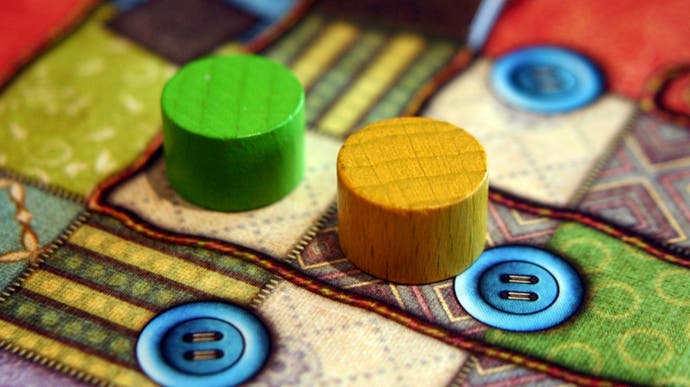Dicebreaker Recommends: Patchwork, a two-player board game that's as warm and comforting as its cardboard quilts
You up-holstery?
Dicebreaker Recommends is a series of monthly board game, RPG and other tabletop recommendations from our friends at our sibling site, Dicebreaker. Don't forget to also check-out their list of the best two-player board games.
When the world outside feels a little scary, there's nothing better than curling up with something comforting. Patchwork, a two-player tabletop title about making a quilt, is the absolute definition of a comfort board game. Its theme is seeped in an old-timey Americana or Scandinavian feel, so much so that you can almost smell the dust bunnies and fresh baking whenever you open its box.
That theme isn't the only aspect that makes it comforting - the gentle pace and light competitiveness of its gameplay allows it to be a kinder experience. Players might be trying to score more points than their opponent, but Patchwork rarely involves the kind of brutal interactions one might expect from other head-to-head board games.
Patchwork's presentation is a huge part of its appeal. It's rare that a theme so potentially mundane as sewing can become such an attractive feature, but Patchwork manages it. From the charming 'fabric' pieces to the little blue buttons and wooden spool, playing Patchwork evokes images of warm afternoons in a lounge chair with no disturbances besides the crackling of a fire and the purring of a cat.
Enough swooning over the game's components; how does Patchwork actually play? Each player starts with their own board that they must attempt to fill with the game's different fabric pieces. Covering as much board space as possible is important as, at the end of the game, each square left empty is one point subtracted off your total.
You can avoid this fate by carefully selecting pieces that are going to fit well together. However, you and your opponent will be taking from the same shared market, which means you'll need to compete to get a hold of the tiles that you want. Throughout the game, you'll be taking it in turns to select pieces from a circle in the middle of the table, using whatever buttons you have to make your purchases.

Buttons are the currency in Patchwork, earned by placing pieces showing buttons onto your board. Whenever a player's time token moves beyond a button icon on the time track, both players take however many buttons they have on their board from the game and into their own piles. Whilst getting pieces with buttons on certainly helps - players score by having buttons - you can also get a bonus for being the first to fill a seven-by-seven area of your board.
However, players won't be able to buy just any piece from the shared market, as they'll have to choose between whichever three tiles are just ahead of the game's wooden spool. Whenever a player takes a piece from the circle, they move the spool to fill the space that piece once occupied - thereby opening up new options for future purchases.
The limitations caused by the spool's placement stops players from immediately taking the largest pieces or those with the most buttons on them. Instead, players need to choose carefully between a smaller selection of pieces that might not be exactly what they want - but could be incredibly advantageous if utilised property. There's also potential for players to strategically pick certain pieces just to prevent their opponent from getting their hands on whatever they might be eyeing up. As the number of available pieces decreases, players will have to be even more discerning in their choices, making sure not to waste their precious buttons on potential junk.
Alongside buttons, players may have to pay for pieces via spaces on the time track. The time track represents how long players have until the game ends, with the board spiralling all the way to the final turn. You'll need to move your time token ahead however many spaces are shown on whichever piece you've just bought. Whenever a player's time token is behind their opponents on their turn, they'll also have the option to move their token up to the other player's to gain some extra buttons - should they ever be out of pocket.
The time track is another really clever aspect of Patchwork's design, as it presents a risk versus reward element to the game - with players sacrificing more time to work on their quilt in favour of acquiring a desirable piece or extra currency. It turns what could be a simple time tracker into an essential aspect of the gameplay.
Patchwork is more than just a pretty picture; it's a delight to play thanks to how it challenges players to make small choices without threatening them with enormous consequences to messing up. It's the kind of game that you'll want to play again and again, not just because of the comfort it brings, but because you learn how to make better decisions every time you play.



